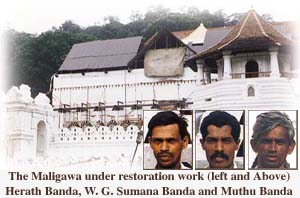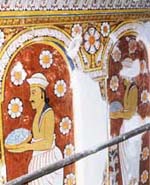
Brick by brick, tile by tile, the work continues. The devotees
are impatient but authorities insist that such a significant project cannot
be hurried.
By Dilrukshi Handunnetti
 Like
the mythi cal phoenix ris ing from the ashes the Dalada Maligawa which
suffered a dawn attack by the LTTE on January 25 is gradually rising to
its former glory. But the slow pace of restoration work has caused consternation
among devotees eager to see the hallowed shrine restored. Like
the mythi cal phoenix ris ing from the ashes the Dalada Maligawa which
suffered a dawn attack by the LTTE on January 25 is gradually rising to
its former glory. But the slow pace of restoration work has caused consternation
among devotees eager to see the hallowed shrine restored.
The brutal attack wounded not only Buddhists but all Sri Lankans who
took pride in the Temple of the Tooth as the country's foremost national
symbol. Hence the hurt which transcended all boundaries was felt by all,
alike.
The debris has been cleared long since, and the revered Maligawa has
been open to the public from February 10. Religious programmes are being
conducted as usual.
The roof of the inner chambers which was badly damaged has been temporarily
completed while the entire roof is being redone as a priority concern.
A group of ten carpenters were busy at work when we paid a visit to the
Maligawa.
Young Janaka Priyantha of the State Engineering Corporation said that
public response to the restoration was tinged with impatience, with people
inquiring constantly as to the progress of the work.
"The Magul Maduwa which had beautifully carved wooden pillars is
getting a face lift in addition to an entirely new roof. We are awed by
the structural strength and elegance of the previous work. The roofs of
the octagonal inner chamber and the Magul Maduwa took two months to complete
while the permanent roof would take about four months," he said.
Many others are eagerly working to restore the once spectacular appearance
of the Temple. Herath Banda, a mason who is striving to restore the heavily
pierced and splintered architectural wall Walakulu Bemma said that it was
such a tragedy that people could blow up shrines of such artistry, history
and religious significance.
"Being a Kandyan myself, I shed tears when I first came here. I
want to restore it to its pristine glory, for it hurts to see its present
state. Each layer of cement and each brick we lay is important for this
reason."
But some things could never be repaired or restored. The bomb which
caused severe structural damage to the Maligawa, also destroyed invaluable
stone carvings beyond repair such as the Sandakadapaha (Moonstone) which
is to be transferred to the museum once its replica is ready to replace
the original.
According to H. G. Muthu Banda, it could take months to carve the Moonstone,
and similarly the elephant images at the foot of the temple entrance (Wahalkada)
both of which are to be carved of stone.
The Wahalkada which took the impact of the blast has been patched up.
The blast also damaged the Paththirippuwa (octagonal chamber), structure
of the Pallemale (lower floor), the drummers' court yard though the ante
chamber where the relic casket is placed miraculously escaped the blast.
It was King Sri Wickramasinghe Rajasinghe with a vision to create a
city of unparalleled elegance and architectural finesse, who constructed
the Paththirippuwa (octagon) and the picturesque Walakulu Bemma (decorative
short wall) around the Kandy Lake.
The Paththirippuwa which also suffered the severe blow is being retiled
and is partially covered with cloth.
What really retards the work is the delays in making the specific tiles
and bricks. Special tiles are being made in three villages reputed for
pottery and tile work. But for the impatient devotees, the reconstruction
process is not fast enough. Authorities handling the project say that a
project of such magnitude could not be hurried.
Headed by a team of professionals from the Central Cultural Fund, over
twenty areas are being looked into by the restoration team. The State Engineering
Corporation, Buildings Department, Ports Authority, Water and Drainage
Board and several other government departments are also co-ordinating their
efforts. The Ceylon Electricity Board has undertaken to rewire the entire
palace complex.
Since the Maligawa blast, city security has been tightened. Several
minor roads leading to the temple of the Tooth Relic have been closed.
A devotee has to go through a vigorous body search process prior to
gaining entry to the Maligawa now, and the destroyed Wahalkada entrance
remains closed to the public. When we visited the Temple, people were working
with renewed vigour, expecting a visit from President Kumaratunga who was
scheduled to review restoration.
But the custodian of the Temple, Diyawadana Nilame Neranjan Wijeratne
claims that despite his repeated requests before and after the devastating
blast for a security beef up, nothing has been done.
The Mahanayakes and he have requested for the deployment of two Police
and Army battalions on a permanent guard, removal of the Kandy courts complex
from the vicinity, erection of new barricades and closure of several roads
in the surrounding area.
"We opened the sacred shrine to the public within a fortnight,
for we appreciate the sentiments of the devotees. But the construction
cannot be hurried due to many practical problems. Restoration of the Maligawa
has to be a perfect job, for it has much historical significance. This
is why the chief prelates disagreed on any kind of camouflage work.
The Chief Conservator of Mural Paintings of the Central Cultural Fund
Ananda Colombage said that some of the paintings would be preserved in
their present form as evidence of the LTTE's atrocity.
"Certain paintings have been damaged far too severely for us to
restore them, but most of them will be restored," he said.
 But
the mural painters have a problem. Modern paints cannot give the murals
that age old weathered look and paints have to be constantly remixed to
achieve the original colour. But
the mural painters have a problem. Modern paints cannot give the murals
that age old weathered look and paints have to be constantly remixed to
achieve the original colour.
Minister Lakshman Jayakody who heads the Restoration Committee believes
that the unfortunate incident has hurt the religious sentiments of the
people tremendously. But the restoration of the Maligawa had to be a thorough
job which might consume considerable time, he says. This is necessary in
order to prevent slip shod work which would prove detrimental in the long
run.
The Temple which was open to the public from 6 am to 8.30 pm earlier
has revised its official hours. Today, people are admitted only from 9
am to 4 pm, though devotees conducting the thewawa, the poojawa at dawn
and dusk are not subjected to this restriction.
As we made our way through the hallowed precincts, the throb of drums
inside the drummers' court yard could be heard, signifying the performance
of an age old tradition, symbolic of the Maligawa sub-culture.
More Plus * It shall not be delivered * Department
or Corporation? * What went before

Plus Archive
Front Page| News/Comment|
Editorial/Opinion| Business|
Sports | Mirror Magazine
|









